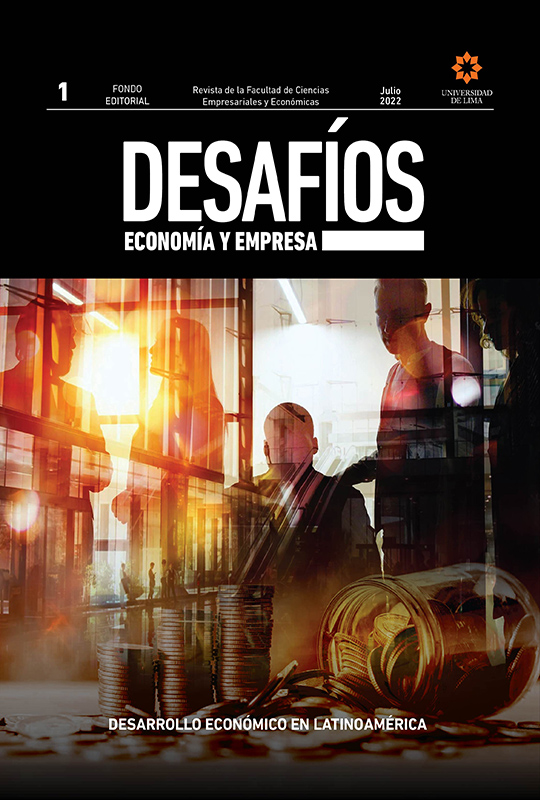Demographic Trends in Peru: Projections to 2050
DOI:
https://doi.org/10.26439/ddee.vi001.5382Keywords:
population, fertility, demography, PeruAbstract
This paper performs a descriptive analysis of the evolution of the main demographic variables in Peru to 2050. The evolution of the total fertility rate, the population structure by age, the dependency ratio and the demographic bonus are analyzed. It is observed that: (i) fertility is falling steadily and will reach 1,7 children per woman in 2050; (ii) the child population will be reduced while there will be an increase in the elderly population becoming more than 9 million in 2050; (iii) the dependency ratio will increase due to an increase in the elderly population.
Downloads
References
Adsera, A. (2004). Changing fertility rates in developed countries. The impact of labor market institutions. Journal of Population Economics, 17(1), 17-43.
Adsera, A., & Menéndez, A. (2011). Fertility changes in Latin America in periods of economic uncertainty. Population Studies, 65(1), 37-56.
Arce Mesa, A. F., Rodríguez, D. L., & Garavito, S. F. (2012). Determinantes de la fecundidad en el Departamento de Antioquia. Criterio Libre, 10(17), 25-52.
Bloom, D. E., Canning, D., Mansfield, R. K., & Moore, M. (2007). Demographic change, social security systems, and savings. Journal of Monetary Economics, 54(1), 92-114.
Bloom, D. E., Canning, D., & Sevilla, J. (2003). The demographic dividend. A new perspective on the economic consequences of population change. RAND.
Bloom, D. E., & Williamson, J. G. (1997). Demographic transitions and economic miracles in emerging Asia [Working Paper n.° 6268]. National Bureau of Economic Research.
Blue, L., & Espenshade, T. J. (2011). Population momentum across the demographic transition. Population and Development Review, 37(4), 721-747.
Bohk-Ewald, C., Li, P., & Myrskylä, M. (2018). Forecast accuracy hardly improves with method complexity when completing cohort fertility. Proceedings of the National Academy of Sciences of the United States of America, 115(37), 9187-9192.
Carvalho, C., Ferrero, A., & Nechio, F. (2016). Demographics and real interest rates: inspecting the mechanism. European Economic Review, 88(C), 208-226.
Cavallo, E., Sánchez, G., & Valenzuela, P. (2018). Gone with the wind: demographic transitions and domestic saving. Review of Development Economics, 22(4), 1744-1764.
Coutinho, R. Z., & Golgher, A. B. (2018). Modelling the proximate determinants of fertility for Brazil: the advent of competing preferences. Revista Brasileira de Estudos de População, 35(1), 1-28.
Ferrando, D., & Aramburú, C. E. (1992). La transición de la fecundidad en Perú. Notas de Población, 55, 173-202.
García Núñez, L. (2012). Desprotección en la tercera edad: ¿estamos preparados para enfrentar el envejecimiento de la población? [Documento de trabajo n.° 2012-330]. Pontificia Universidad Católica del Perú, Departamento de Economía.
Guerra García, R. (1991). Las políticas sobre población en el Perú. Thēmis: Revista de Derecho, 19, 73-77.
Guinnane, T. W. (2011). The historical fertility transition: a guide for economists. Journal of Economic Literature, 49(3), 589-614.
Hanmer, L., Lensink, R., & White, H. (2003). Infant and child mortality in developing countries: analyzing the data for robust determinants. Journal of Development Studies, 40(1), 101-118.
Heuveline, P., & Hirschman, C. (2015). Fertility transition: Southeast Asia. En J. D. Wright (Ed.), International Encyclopedia of the Social and Behavioral Sciences (pp. 84-91). Elsevier.
Instituto Nacional de Estadística e Informática. (2018). Indicadores de empleo e ingreso por departamento, Perú: 2007-2017.
Instituto Nacional de Estadística e Informática. (2019). Perú: estimaciones y proyecciones de la población nacional, 1950-2070. Boletín de Análisis Demográfico, 38. https://www.inei.gob.pe/media/MenuRecursivo/publicaciones_digitales/Est/Lib1665/index.html
Juárez, F., & Gayet, C. (2015). Fertility transition: Latin America and the Caribbean. En J. D. Wright (Ed.), International Encyclopedia of the Social and Behavioral Sciences (pp. 68-72). Elsevier.
Lee, J. H., Lim, E. S., & Hwang, J. (2012). Panel SVAR model of women’s employment, fertility, and economic growth: a comparative study of East Asian and EU countries. The Social Science Journal, 49(3), 386-389.
Lee, R. (2003). The demographic transition: three centuries of fundamental change. Journal of Economic Perspectives, 17(4), 167-190.
Lee, R., Lee, S.-H., & Mason, A. (2007). Charting the economic lifecycle. Population and Development, 33(27), 208-237.
Martínez, C. (2013). Descenso de la fecundidad, bono demográfico y crecimiento económico en Colombia, 1990-2010. Serie de Estudios a Profundidad. https://www.minsalud.gov.co/sites/rid/Lists/BibliotecaDigital/RIDE/INEC/INV/1%20-%20DESCENSO%20DE%20LA%20FECUNDIDAD%20-%20BONO%20DEMOGRAFICO%20Y%20CRECIMIENTO%20ECONOMICO%20EN%20COLOMBIA%201990-2010.pdf
Medina Hernández, E. J. (2012). Diferenciales regionales de la fecundidad según el nivel educativo de las mujeres colombianas en edad fértil. Sociedad y Economía, 23, 205-234.
Murthi, M. (2002). Fertility change in Asia and Africa. World Development, 30(10), 1769-1778.
O’Hare, B., Makuta, I., Chiwaula, L., & Bar-Zeev, N. (2013). Income and child mortality in developing countries: a systematic review and meta-analysis. Journal of the Royal Society of Medicine, 106(10), 408-414.
Pinto Aguirre, G. (2011). El bono demográfico: una oportunidad de crecimiento económico. Umbrales. Revista del Postgrado Multidisciplinario en Ciencias del Desarrollo, 22, 107-117.
Pinto Aguirre, G. (2016). El bono demográfico en América Latina: el efecto económico de los cambios en la estructura por edad de una población. Población y Salud en Mesoamérica, 13(2), 191-210.
Puig-Barrachina, V., Rodríguez-Sanz, M., Domínguez-Berjón, M. F., Martín, U., Luque, M. Á., Ruiz, M., & Pérez, G. (2020). Decline in fertility induced by economic recession in Spain. Gaceta Sanitaria, 34(3), 238-244.
Rizk, R. (2019). Does demographic transition matter for economic growth? Evidence from Egypt. Journal of North African Studies, 24(6), 1012-1035.
Sánchez-Páez, D. A., & Ortega, J. A. (2018). Adolescent contraceptive use and its effects on fertility. Demographic Research, 38(45), 1359-1388.
Stefanelli, M., Valenzuela, M. T., Cárcamo, M., Urquidi, C., Cavada, G., & San Martín, P. (2016). Tendencia de la tasa global de fecundidad y el aumento de la fuerza laboral femenina en Chile. 1960-2011. Revista Médica de Chile, 144(5), 658-663.
Wongboonsin, K., Guest, P., & Prachuabmoh, V. (2005). Demographic change and the demographic dividend in Thailand. Asian Population Studies, 1(2), 245-256.


